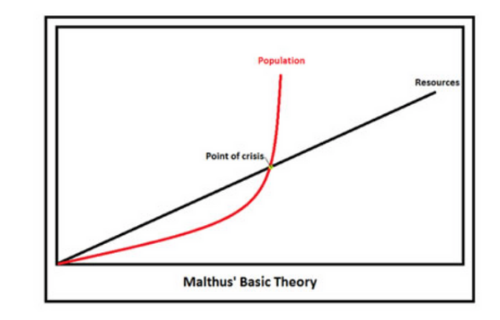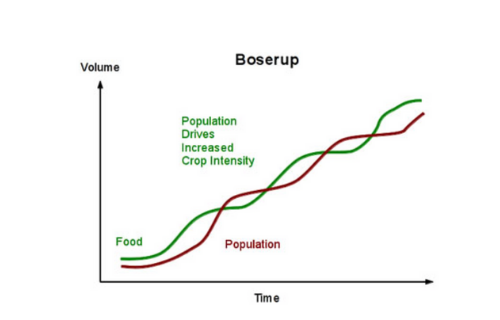Difference Between Malthus and Boserup Theory
Malthus and Boserup had opposing views on the relationship between population expansion and food supply.

What is Malthus?
Reverend Malthus predicted in 1798 that the rate of global population growth would inevitably result in a population larger than could be fed, because the number of people was growing faster than the world’s ability to produce food, and there would eventually be too many people for the available food. He predicted a disaster including hunger and conflict, after which the population would rebound to a level that could be sustained by the food available.

What is Boserup?
Ester Boserup coined the phrase “necessity is the mother of invention” in the 1960s. She believed that no matter how large the world’s population increased, people would always be able to produce enough food to suit their requirements. She prophesied that when the world’s food supply became depleted, people would respond with technical advancements that would improve food production. There would also be a population-wide effort to cut food consumption, which would ‘buy’ time for a solution to be devised.
Neither idea has been proven completely correct or incorrect. Famines have occurred in some locations, but overall, the production of food has maintained pace with population expansion.
Difference between Malthus and Boserup Theory: Comparison Chart

Summary
The Malthusian theory is named after Thomas Malthus, who proposed that the world population is growing exponentially while global resource production and extraction are only expanding arithmetically. As a result, he believes that there will come a day when the Earth’s resources will no longer be able to feed the ever-increasing population.
Boserup’s point of view is opposed. She thinks that the population is a resource in and of itself. Humans have the ability and knowledge to address resource scarcity by developing innovative methods of resource extraction and production. New methods of food production, such as fertilisers, food technology, genetically modified crops, and new techniques for finding oil reserves, all support this viewpoint. The Earth’s carrying capacity is increased as a result of this (even though points of crisis may be encountered on the way).
Problems The Malthusian Hypothesis Theorem of Boserup Malthus thinks that the human population is a ‘closed system.’ Bosrup thinks that the human population is a ‘closed system.’ Food resources are not distributed in a fair and equal manner. Only the poorest people are truly hungry. Human actions have resulted in the desertification of vast swaths of land in some cases. Malthus could not have imagined the incredible technological advancements that have occurred since his time. Food shortages in LEDCs lead to emigration rather than innovation. The availability of food resources has not risen ‘arithmetically.’ MEDCs are the source of innovation, which isn’t usually shared with LEDCs. The internationalisation of food supplies was not predicted by Malthus. Both views may be correct but in different ways. Boserup was talking about cultural and technical difficulties, whereas Malthus was referring to environmental restrictions.
FAQs
What is the basic differencebetween the Malthus and the boserup views on the relationship between population growth and resources?
The quantity and expansion of the population, according to Malthusian theory, are determined by food availability and agricultural systems. Agricultural practises, according to Boserup’s idea, are dependent on population growth. When there isn’t enough food for everyone, according to Malthus, the excess population will perish. The Malthusian theory is named after Thomas Malthus, who proposed that the world population is growing exponentially while global resource production and extraction are only expanding arithmetically. As a result, he believes that there will come a day when the Earth’s resources will no longer be able to feed the ever-increasing population.
Boserup’s point of view is opposed. She thinks that the population is a resource in and of itself. Humans have the ability and knowledge to overcome resource scarcity by developing innovative methods of resource extraction and production. New methods of food production, such as fertilisers, food technology, genetically modified crops, and new techniques for finding oil reserves, all support this viewpoint. The Earth’s capacity factor is increased as a result of this (even though points of crisis may be encountered on the way).
What is boseruptheory of population?
Esther Boserup (1920–1999) was a Danish economist who lived from 1920 to 1999. He felt that population growth occurs in a different (and quicker) manner than food production. He prophesied that when the population outnumbers the food supply, famine, conflict, and illness will inevitably result. This results in a sharp drop in population.
According to Boserup, population increase is the cause, not the effect, of agricultural change, and the most significant shift is the intensification of land usage. According to Boserup, population expansion is independent of food availability, and population growth is a cause of agricultural changes. The interrelationships between population change and economic development, as well as between population increase and food supply, have been extensively studied. However, there has been little discussion of the impact of population growth on agriculture—on land use, technology, and land tenure—and it has been assumed for the most part that the consequences are negative, leading to overpopulation: farm subdivision and fragmentation, falling real wages, landlessness and underemployment, soil erosion, and overgrazing.
What did boserup believe about population and resources?
Esther Boserup (1920–1999) was a Danish economist who lived from 1920 to 1999. He felt that population growth occurs in a different (and quicker) manner than food production. He prophesied that when the population outnumbers the food supply, famine, conflict, and illness will inevitably result. This results in a sharp drop in population. The Boserupian hypothesis, which appeared in 1965, proposed an alternative rationale. This hypothesis was founded on the premise that population increase benefits people because it encourages them to come up with innovative ways to get more food when resources run out.
The planet’s natural resources are being depleted at an alarming rate by the world’s rapidly rising population. According to the Global Footprint Network, the world presently requires 1.6 Earths to meet the demand for natural resources, and this number might climb to 2 planets by 2030. Advanced nations (ACs) have the greatest levels of resource use, and if everyone on the earth lived like Americans, five planets would be required. Even though many established nations are starting to cut their consumption, emerging and developing countries (EDCs) continue to industrialize and consume more.
- Difference Between Vascular Cambium and Cork Cambium - November 1, 2023
- Difference Between DevOps and Developer - September 10, 2023
- Difference Between Acute Gastritis and Chronic Gastritis - April 3, 2023
Search DifferenceBetween.net :
Leave a Response
References :
[0]Grigg, David. "Ester Boserup's theory of agrarian change: a critical review." Progress in human geography 3.1 (1979): 64-84.https://www.mytutor.co.uk/answers/3889/IB/Geography/What-is-the-difference-between-Thomas-Malthus-and-Ester-Boserup-s-view-on-population-growth/
[1]Egger, Claudine, et al. "Socio-ecological trajectories in a rural Austrian region from 1961 to 2011: comparing the theories of Malthus and Boserup via systemic-dynamic modelling." Journal of Land Use Science 15.5 (2020): 652-672.
[2]Soby, Scott. "Thomas Malthus, Ester Boserup, and agricultural development models in the age of limits." Journal of Agricultural and Environmental Ethics 30.1 (2017): 87-98.
